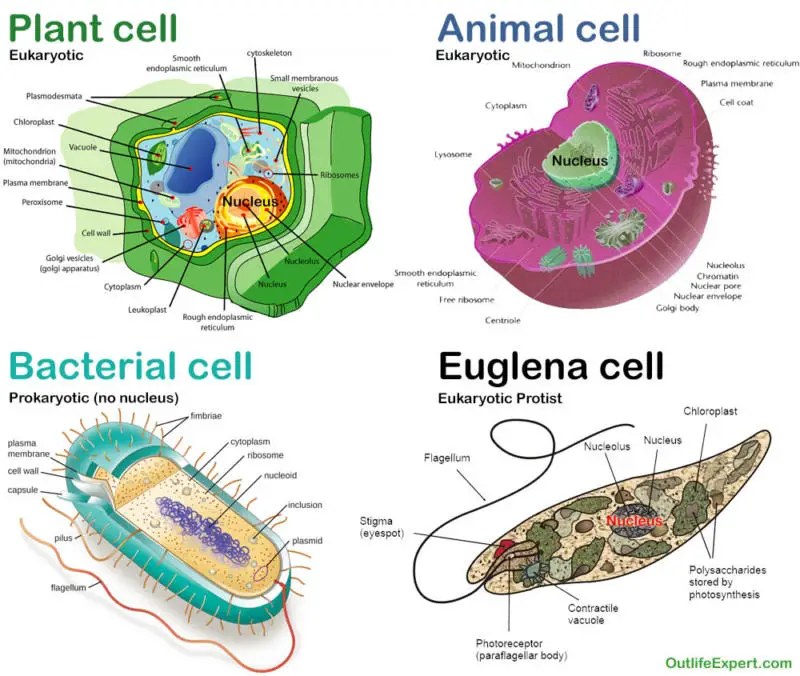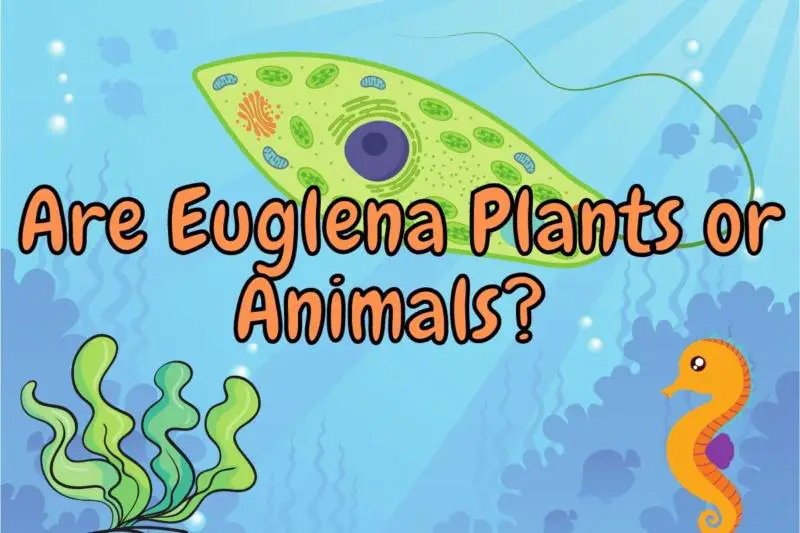Euglena is a group of single-celled algae that live in both fresh and saltwater environments, including moist soil.
Euglena are actively photosynthesizing like plants while in light, but turns colorless and obtain their energy from other sources, like animals, when removed from the light. In that sense they have capabilities of both plants and animals but belong to a different class of organisms that we will discuss here.
This means that euglena are not animals or plants but protists that behave like animals in the dark and like plants in the light.
To understand where in the tree of life euglena belong, it is helpful to understand the Linnean classification system, which organizes living organisms into categories based on similarities between the organisms.
The classification of living organisms, in order from most broad to most specific as are follows (the affiliation of Euglena is shown in parenthesis):
- Kingdom (Eukaryota)
- Phylum (Euglenozoa)
- Class (Euglenoidea)
- Order (Euglenida)
- Family (Euglenaceae)
- Genus (Euglena)
- Species (There are >800 Euglena species)
Euglena was discovered in the 1674 by Dutch scientist Antoni van Leeuwenhoek. In a letter to the Royal Society, van Leeuwenhoek described his discovery:
They look like “animalcules” that are “green in the middle, and before and behind white.”
Antoni van Leeuwenhoek 1674
They are the best known and most widely studied member of the class euglenoidea, with 54 genera and at least 800 species. They have been heavily researched since their discovery.
Some species of euglena (Euglena viridis and Euglena sanguinea) are infamous algae that form green or red toxic ‘blooms’ in ponds of lake.
This happens when the bodies of water where these Euglena species live have a high nitrogen content – which is often the limiting nutrient for Euglena in nature.
The microorganisms themselves or the toxic substances they release can discolour the water, deplete water oxygen content, poison aquatic animals and waterfowl, and irritate the skin and respiratory tract of humans who come in contact with it.
Contents
Are euglena prokaryotic or eukaryotic?
All life is either prokaryotic or eukaryotic. Euglena belongs to the kingdom of Eukaryotes because they have a nucleus.
These terms classify whether or not cells have a nucleus that is surrounded by a membrane.
Eukaryotes have a nucleus, and prokaryotes do not.
Eukaryotes store their genetic information in the nucleus, whereas the DNA of prokaryotes is bundled in the nucleoid region, but it isn’t stored within a membrane-bound nucleus.
The type and shape of the genetic information, or DNA, is also different between eukaryotes and prokaryotes.
Eukaryotes include:
- Protists
- Plants
- Animals
- Fungi
Prokaryotes include:
- Bacteria
- Archaea
Euglena are Eukaryotes that are further classified as protists because they are not animals or plants.

Why are Euglena not considered bacteria?
While bacteria and Euglena are both single celled organisms that may look somewhat similar, they have many differences which mean that bacteria are not considered bacteria.
The main difference is that Euglena are eukaryotic, and all bacteria are prokaryotic. Some minor differences include the cell wall of bacteria are made of peptidoglycan.
Because Euglena have a nucleus and other organelles, they are naturally larger in size.
Whereas bacteria measure around 1 micrometer, the largest species of Euglena measures up to 500 micrometers, making Euglena up to 500 times larger than most bacteria.
In comparison, Euglena do not have a cell wall – instead, they have a cell membrane which allows them more flexibility and less rigidity than a typical cell wall.
Like many bacteria, Euglena cells have flagella, which are tail-like appendages that are used for movement.
Euglena also contain chloroplasts, which no bacteria possess as a chloroplast would be approximately the same size as the bacteria themselves (and would therefore not fit inside one!).
Although some bacteria like cyanobacteria do generate energy via photosynthesis it is done via processes their own membrane and not via choloplasts. In fact, chloroplasts are thought to be cyanobacteria engulfed by the larger eukaryotes we now know as plants or protists.
Why are euglena not plants?
Euglena and plants have several similarities, which resulted in some contention over how euglena should be classified, since its original discovery and identification.
Most species of euglena have chloroplasts within the body of the cell for photosynthesis, which allows them to feed by autotrophy, like plants, when enough light is available.
Euglena are autotrophs (translates directly to “self-feeding”), also known as primary producers, which means organisms that produce their own food using energy from sunlight.
Additionally, both euglena and plants are eukaryotic. Despite these similarities, euglena are not considered plants, or part of Kingdom Plantae, because euglena is single-celled organisms and plants are multi-cellular organisms.
Another important feature that distinguishes Euglena from plants is that they don’t have cell walls, whereas plants have thick cell walls composed of cellulose.
Why are euglena not animal cells?
Euglena also have several similarities with animal cells, once again leading to debate over classification.
Most animals are heterotrophs (consumers), because they need food from other organisms such as plants (producers). Very few animals can produce their own food, however, there are examples hereof.
Euglena don’t need the sun for energy as they can also ‘eat’ and be nourished heterotrophically (without the sun), like all animals.
Heterotrophs are organisms that can’t produce their own food, and therefore take their nutrition from other sources, like plant, animal or microbial matter.
Euglena do this using phagocytosis, which means that the cell membrane traps food particles into a vacuole (a cavity filled with fluid and bound with a membrane) to be digested.
This is a helpful adaptation for euglena to be able to survive in periods of light deprivation, where they cannot produce their own nutrients as described earlier. Like euglena, animal cells also don’t have a cell wall.
Despite these similarities, euglena are single-celled organisms, whereas animal cells are multi-cellular. Therefore, euglena cannot be classified as animals in the Kingdom Animalia.
Can you call Euglena plant-animals then?
In short, no. Euglena cannot be classified as bacteria, plant cells, or animal cells.
Euglena were difficult to classify, since they have features of both plants and animals. But scientists have determined that euglena cannot be classified as both plant and animals.
They have their own classification, which will be discussed next.
What kingdom do Euglena belong to?
We have established why euglena cannot be classified as bacteria, plants, or animals. So where do they belong?
Since their discovery and identification in the 1674, the taxonomic classification of euglena has been contentious and have gone through many classification changes.
Euglena have been classified by colour, method of nourishment, shared structural features (such as the number of flagella) and more.
Genetic analysis in the 1990s increased our understanding of euglena and how various species are related.
Early scientists found them difficult to classify since they have features consistent with both animal and plant cells.
This prompted Ernst Haeckel, a German scientist, in 1866 to add a third kingdom to the Linnaean classification system that included Animale and Vegetabile (at the time, now Animalia and Plantae): Kingdom Protis, now called Protista or simply protists.
Protists are a diverse group of organisms, which are usually single-celled, and include amoebas and single-celled algae.
‘Protista’ means ‘the first of all or primordial’ and included ‘all primitive forms’, and initially included bacteria.
Bacteria were eventually reclassified by creating a new Kingdom, Bacteria/Eubacteria (formerly called Kingdom Monera).
Protists are now defined as a group of eukaryotes that are not fungi, animals, or plants. They now include organisms such as amoeba, slime molds, algae (including some seaweeds) and ciliates.
References
Books:
Euglena; an experimental organism for biochemical and biophysical studies. Appleton-Century-Crofts; 2nd edition (January 1, 1967).
Euglena: Biochemistry, Cell and Molecular Biology. Steven D. SchwartzbachShigeru Shigeoka. Springer publishing 2017.
The Biology Of Euglena, Volume III: Physiology. Academic Press 1982.
Websites:
https://www.britannica.com/science/Euglena
https://pubmed.ncbi.nlm.nih.gov/28429314/
https://www.livescience.com/54242-protists.html
http://scienceline.ucsb.edu/getkey.php?key=3694
Graphics and illustrations adapted from:
CNX OpenStax, CC BY 4.0 via Wikimedia Commons.
https://commons.wikimedia.org/wiki/File:Euglena_diagram.jpg
https://commons.wikimedia.org/wiki/File:OSC_Microbio_03_03_ProkCell.jpg
https://commons.wikimedia.org/wiki/File:Eukaryotic_Cell_(animal).jpg
https://commons.wikimedia.org/wiki/File:Plant_cell_structure.png




